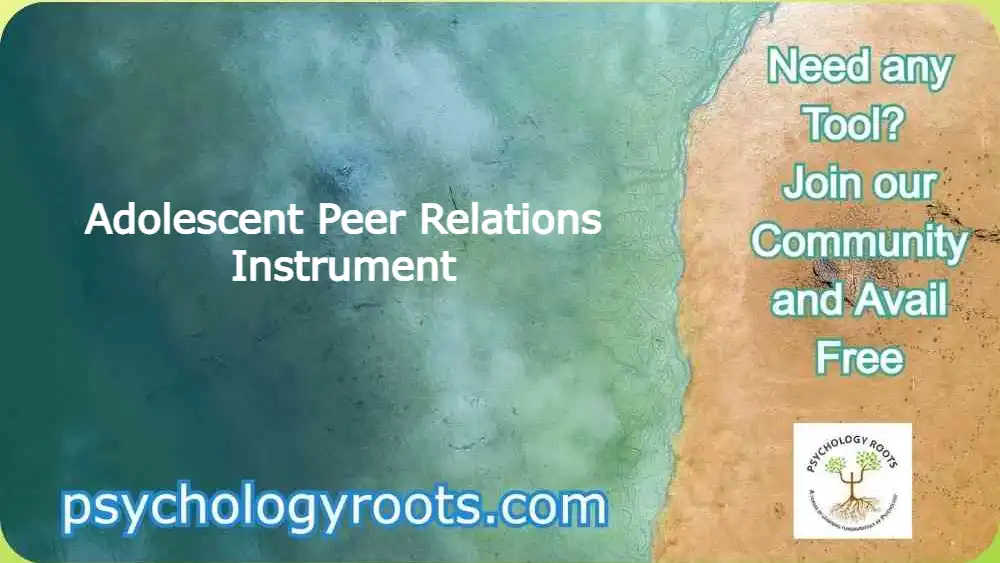Table of Contents
Adolescent Peer Relations Instrument
Here in this post, we are sharing the “Adolescent Peer Relations Instrument”. You can read psychometric and Author information. We have thousands of Scales and questionnaires in our collection (See Scales and Questionnaires). You can demand us any scale and questionnaires related to psychology through our community, and we will provide you with a short time. Keep visiting Psychology Roots.
About Adolescent Peer Relations Instrument
APRI-BT is a 36-item questionnaire (Parada, 2000), developed for measuring bullying perpetration and victimization among youths, each in relation with three subdomains—physical, verbal, and social (see Appendix B). For the Bullying section, children are asked to rate the frequency of a series of behaviors perpetrated against other children, during the last school year (e.g., “Got into a physical fight with a student because I didn’t like them”). For the Victimization section, children are asked to evaluate the frequency with which they were the targets of these behaviors, during the last school year (e.g., “I was called names I didn’t like”). The items are measured using a 6-point Likert-type response scale (1 ¼ never; 2 ¼ sometimes; 3 ¼ once or twice a month; 4 ¼ once a week; 5 ¼ several times a week; 6 ¼ every day).
Responses closer to 1 represented infrequent involvement in bullying victimization, whereas scores closer to 6 represented frequent amounts of involvement in bullying victimization. Scores for each of the two sections range between 18 and 108, with higher scores indicating higher levels of bullying behavior or victimization. Regarding the three main criteria for defining bullying—repetition, intention, and power imbalance—note that APRI-BT does not directly and explicitly measure the type or amount of power imbalance component of bullying. Instead, the theoretical assumption of the instrument is that being able to perpetrate aggression repeatedly to others over time is possible, by implication, due to the fact that such an individual is at a “higher” power status than those who report being the targets of such behavior.
Inversely, targets, therefore, are at a “lower” power status as they are clearly unable to stop being targeted on a repeated basis (for a detailed debate over validity in assessing power imbalance, see Jia & Mikami, 2018). Moreover, previous studies found that whether or not questions included a definition of bullying involving intentionality and power Journal of Interpersonal Violence 0(0) imbalance had no impact on students’ likelihood of self-reporting bullying involvement (Huang & Cornell, 2015).

Adolescent Peer Relations Instrument
Avail Reference Files: [sociallocker id=64051]
Roberto Parada‚ PhD
Email: r.parada@uws.edu.au.
- Parada‚ R. H. (2000). Adolescent Peer Relations Instrument: A theoretical and empirical basis for the measurement of participant roles in bullying and victimization of adolescence: An interim test manual and a research monograph: A test manual. Penrith South‚ DC‚ Australia: Publication Unit‚ Self-concept Enhancement and Learning Facilitation (SELF) Research Centre‚ University of Western Sydney.
[/sociallocker]
Information:
The purpose of our website is only to help students to assist them in finding the best suitable instrument for their research, especially in Pakistan where students waste a lot of time in search of the instruments. It is totally free of cost and only for creating awareness and assisting students and researchers for good research. Moreover, it is necessary for you to take the permission of scales from their representative authors before use because copyrights are reserved by the respected authors.
Help Us Improve This Article
Did you find an inaccuracy? We work hard to provide accurate and scientifically reliable information. If you have found an error of any kind, please let us know.
Add comment. we appropriate your effort.
If you have any scale or any material related to psychology kindly share it with us at psychologyroots@gmail.com. We help others on behalf of you.
Follow